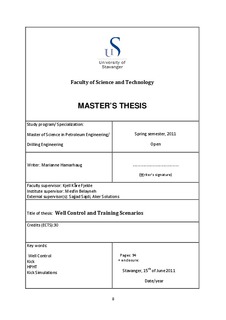| dc.contributor.author | Hamarhaug, Marianne | |
| dc.date.accessioned | 2011-10-28T10:52:42Z | |
| dc.date.available | 2011-10-28T10:52:42Z | |
| dc.date.issued | 2011 | |
| dc.identifier.uri | http://hdl.handle.net/11250/183373 | |
| dc.description | Master's thesis in Petroleum engineering | no_NO |
| dc.description.abstract | Well control is needed during drilling operations to maintain a stable and safe well. Moving towards deeper wells with higher pressures and temperatures makes the operational working window smaller and more complicated than for conventional wells. In this work some of the challenges when dealing with a HPHT well environment are identified.
During conventional well operations it is desirable to keep the well pressures above the pore pressure and below the fracture pressure in the formation. This is to avoid inflow of formation fluids into the wellbore or the flow of drilling mud into the formation. The pore pressure prognosis is therefore very important in the casing and drilling mud design.
The well control aspects are described focusing on kick causes, kick detection and the well kill procedures.
The simulation set up was based on a constructed HPHT well case. The simulations and analysis in this work is focused on pressure and volume development in the well during a kick circulation, focusing on the differences when circulating out a kick in OBM, where the gas will dissolve in the mud, and a WBM, where gas migration will occur. A comparison between a kick circulated out in an OBM and in a WBM shows that in general the well pressures and gas volumes in the well will be higher when the kick is taken in a WBM
Simulations were also done looking at the pressure effect experienced when performing connections and swabbing operations. Here it was shown that the pressure drop experienced during connections can lead to an underbalanced situation where we get an inflow of formation fluids. It is also seen that the pressure drop during connections increases in smaller hole section and it is also seen that the swabbing effect during tripping out of the well can be reduced by pumping out of the hole. The pressure drop over the bit is also dependent on the pump rate used, an increase in pump rate gives a smaller pressure drop when the pipe is pulled at a high speed. The swabbing effect also gets worse in smaller hole sections. | no_NO |
| dc.language.iso | eng | no_NO |
| dc.publisher | University of Stavanger, Norway | no_NO |
| dc.relation.ispartofseries | Masteroppgave/UIS-TN-IPT/2011; | |
| dc.subject | petroleumsteknologi | no_NO |
| dc.subject | boreteknologi | no_NO |
| dc.subject | well control | no_NO |
| dc.subject | kick | no_NO |
| dc.subject | HPHT | no_NO |
| dc.subject | kick simulations | no_NO |
| dc.title | Well control and training scenarios | no_NO |
| dc.type | Master thesis | no_NO |
| dc.subject.nsi | VDP::Technology: 500::Rock and petroleum disciplines: 510::Petroleum engineering: 512 | no_NO |
